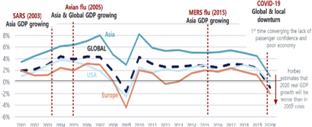| Abstract: | 
COVID-19 pandemic has hit most sectors of the world and has led to many industries coming to a standstill. It has led to restrictions of movement and travel ban. As a result of these restrictions, transport sector especially in aviation has impacted badly.With the uncertainty of further impact of the current situation, there is a likelihood of the aviation business rebounding at a slower pace bringing V-shape and U-shape recovery as per analysis of economic impacts on civil aviation by International Civil Aviation Organization (ICAO (2020). Currently, airline capacity is down 70 to 80 percent in April 2020 compared to April 2019, and multiple large airlines have temporarily ceased operations. Largely, almost 60 percent of the global fleet was grounded in early April 2020 as per McKinsey report (Curley et al., 2020).In order to support the sinking capacities and revenues, the International Air Transport Association (IATA) calls on the European governments to provide relief to their airlines to sustain their operations. Furthermore, this document highlights the future of airport and air transport industry based on revenue generation sources, cost control strategies and integration of innovations with respect to variable demand and capacity during and post COVID-19. |

